In the world of fashion and textiles, two materials stand out for their timeless elegance and luxurious appeal: lace and silk. Both boasting centuries-old histories, lace and silk have adorned royalty, adorned wedding gowns, and graced haute couture runways. Yet, despite their shared association with sophistication, these fabrics possess distinct characteristics that set them apart. Let's delve into the intricate interplay between lace and silk to unravel their unique allure.

Silk, with its origins rooted in ancient China, holds a storied history that spans over thousands of years. Revered for its softness, sheen, and inherent luxury, silk quickly became a symbol of status and wealth. The Silk Road, an ancient network of trade routes connecting East and West, facilitated the spread of silk across continents, cementing its place in global culture.
In contrast, lace emerged in Europe during the Renaissance, with its precise origins shrouded in mystery. Initially crafted by hand using intricate weaving and knotting techniques, lace became synonymous with opulence and femininity. Its delicate patterns and airy texture found favor among aristocrats and nobility, gracing the attire of queens and courtiers alike.


Silk, produced by silkworms, is a natural protein fiber renowned for its lustrous appearance and smooth texture. The process of harvesting silk involves carefully unraveling cocoons spun by silkworms, yielding fine threads that are woven into luxurious fabrics. The result is a material that drapes beautifully, offering both comfort and elegance.
On the other hand, lace encompasses a variety of textile techniques, including knitting, crocheting, and intricate weaving. Traditionally crafted from linen, cotton, or silk threads, modern lace may also incorporate synthetic fibers for added durability and affordability. The hallmark of lace lies in its delicate openwork patterns, created through the meticulous arrangement of threads or yarns.

Silk's versatility knows no bounds, finding application in a myriad of garments ranging from flowing evening gowns to tailored suits. Its inherent drape and breathability make it ideal for both casual and formal attire, while its natural sheen adds a touch of sophistication to any ensemble. Additionally, silk's insulating properties render it suitable for various climates, providing warmth in winter and cooling comfort in summer.


Similarly, lace transcends traditional boundaries, lending its ethereal beauty to bridal wear, lingerie, and delicate accessories. Whether adorning the hem of a wedding gown or embellishing a vintage-inspired blouse, lace evokes a sense of romance and femininity. Its lightweight nature makes it a popular choice for layering, allowing for subtle glimpses of skin while adding a touch of allure to any outfit.
Both lace and silk require delicate handling to preserve their beauty and longevity. Silk garments should be hand-washed or dry-cleaned to avoid damage, as exposure to harsh detergents or agitation can weaken the fibers. Similarly, lace should be laundered with care, preferably using a gentle detergent and cold water to prevent snagging or stretching. Air-drying is recommended for both fabrics, as excessive heat can cause silk to lose its sheen and lace to become misshapen.
In the timeless interplay between lace and silk, we find a harmonious blend of elegance, sophistication, and artistry. While silk captivates with its luxurious sheen and fluid drape, lace enchants with its intricate patterns and delicate textures. Each fabric tells a story of craftsmanship and tradition, weaving together threads of history and culture. Whether adorning a bridal gown or accentuating an evening ensemble, lace and silk stand as testaments to the enduring allure of fine textiles.


